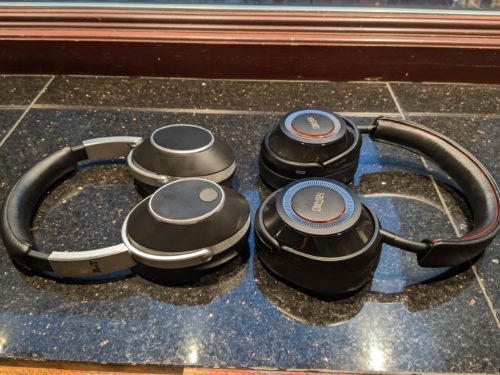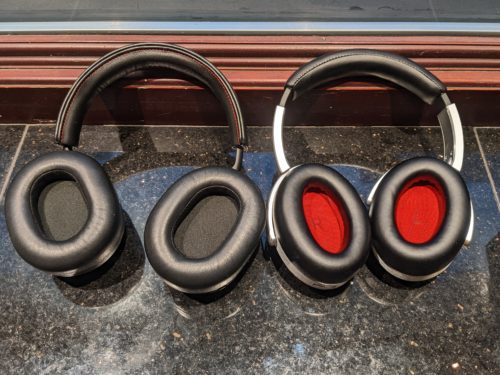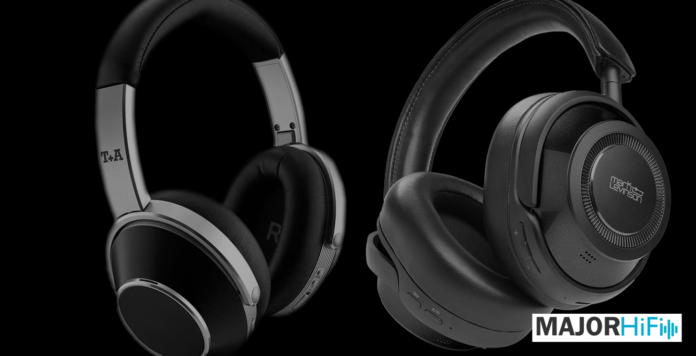T+A Solitaire T vs. Mark Levinson No. 5909 Comparison Review
Today we’re going over two of the most premium over-ear, ANC, wireless releases to have come out in 2022: the T+A Solitaire T and the Mark Levinson No. 5909. When also considering the release of the Focal Bathys and the Bowers & Wilkins PX8 (comparison review found here), 2022 seems to have been the year where a premium tier of pricy Bluetooth headphones has emerged. With the Solitaire T retailing at $1600 and the Mark Levinson No. 5909 at $1000, we’re dealing with the most exclusive releases within this elite tier. What makes these wireless headphones so expensive? And how do they stack up?

What’s In The Box?
| T+A Solitaire T | Mark Levinson No. 5909 |
|
|
Look and Feel
While the No. 5909 features some top grade materials, like anodized aluminum, automotive-grade metallic painted ear cups, and premium leather headbands and cushions, I can’t help but think it has a somewhat plastic appearance. The Solitaire T, on the other hand, looks like the aluminum and composite materials that went into it, sport a subtle metallic sheen under the jet black coloring that adorns the unit I’m using for this review. I appreciate that both headphones go for a discreet look and obfuscate their high price tags, but the Solitaire T does it with a little more couth.
Both headphones have a similar weight, with the Solitaire T a little lighter at 326 grams comparatively to the No. 5909 at 355 grams. Both feature similar high quality leather that feels great against the skin – though the Mark Levinson No. 5909 seems to use a somewhat more breathable ear pad design in contrast to the Solitaire T’s pads. Though the ear cups on both headphones are pretty narrow and shallow, the T+A Solitaire T’s cups are very narrow, and feel a little claustrophobic even on my smaller ears. The No. 5909 pulls off more of a universally-fitting cup size that ultimately felt more comfortable.
While both headphones are fairly comfortable and chic, I think most would agree that the Solitaire T is a little more stylish while the No. 5909 is more comfortable.
ANC, Bluetooth, Battery, Special Features, Technical Specs
- ANC
When it comes to ANC, the Mark Levinson No. 5909 is the clear winner. To be fair, it’s hard to beat: it’s one of the best ANC’s I’ve come across. It managed to reduce the roaring central air unit next to me to a virtual silence. The Solitaire T has perfectly acceptable ANC that brought the same central air unit to a near silence – but it was still somewhat audible. This is about on par with the ANC featured in other current generations of ANC wireless headphones, and I’m pretty much fine with that.
- Battery
When it comes to battery life, the Solitaire T runs laps around the No. 5909 – around nearly every wireless headphone, really. It can support 70 hours of playback on a 2 hour charge, or a more typical 35 hours with “High Quality Mode” turned on. The No. 5909 has a 34 hour playback time in passive mode, or 30 hours with ANC on. So when it comes to battery, the Mark Levinson No. 5909 is somewhere around this generation’s average, which is probably fine.
- Pairing
As for wireless pairing, I struggled a bit to pair the Mark Levinson with both my Pixel 3A phone and 2019 Macbook before eventually getting it. The Solitaire T, however, paired immediately and seamlessly every time I went to use it.
- Extra Features
The No. 5909 has a compatible app, while the Solitaire T appears to have an app pending. The Mark Levinson app is pretty polished, simple, and useful with its best feature likely being the ability to adjust the low end EQ. However, I would probably choose the Solitaire T’s one of a kind “High Quality Mode,” which added very noticeable articulation and smoothness to the low end and high end end, over any app or other feature that normally comes with wireless headphones.
- Microphones and Transparency
Here, I don’t think you can go wrong with either. Both headphones had very crisp call quality that made it hard to imagine anyone complaining about. Both also featured excellent transparency modes that were by and large devoid of the artificial harshness present in many wireless headphones. Environmental noises came through at a reasonable volume relative to the music I was listening to.
| T+A Solitaire T Specs | Mark Levinson No. 5909 Specs |
|
|

Sound Stage
While both of these are certainly premium wireless releases, that doesn’t have much to do with their staging and imaging (the Focal Bathys is still the wireless king in that department). Both present fairly realistic but narrow stages that stayed close to my face. Perhaps the Mark Levinson No. 5909 had a little more going for it in terms of “feeling” pans and movement, but I don’t think it was anything that gave it a serious edge over the T+A Solitaire T. At the end of the day, both headphones left me with a pretty neutral impression. If you want to hear where these two seriously distinguish themselves, look towards their balances. It’s worth noting that the No. 5909 was tuned to the Harman Curve, which is a frequency response that has been researched and developed by Harman International as being the “optimal” sound signature for majority of listeners.
Lows
As one familiar with the Harman Curve might expect, The Mark Levinson No. 5909 has extremely flat and even low end. Subs are subtly present, mid bass is reasonably punchy, high bass is neither muddy nor empty. Bass is heard a bit more than it’s felt, and low frequency masking is entirely absent. Though I’m not generally into bass boosts, I found using the enhanced bass feature in the app gave the otherwise ruler-flat low end response a little bit of spice and excitement.
The Solitaire T, on the other hand, has quite a bit of heft in its low end. Subs are powerful and present though not superfluously so. Mid bass seems to bring most of the low end energy and drive before the Solitaire T scales back some of the high bass. As strong as its low end was, it sat cleanly in the mix, providing lots of energy and a well calibrated contrast to the T’s treble profile.
Though I respect the No. 5909’s tasteful and clean low end, I found the Solitaire T’s lows sounded livelier and more creatively balanced in the overall EQ.
Mids
I’m happy to say that both headphones had fairly balanced and refreshingly clean mid timbres. My most common gripe with wireless audio is with boosted low mids that soften a balance at best, or put it through a pillow at worst. This can often result in overly-present vocal fundamentals that lack realistic overtones, such as fry or air. The moment I heard the crisp balance on vocals from both the Solitaire T and the No. 5909, I knew these were mids profiles that were way ahead of any other wireless headphone available right now. Guitars had their trebly, center-to-high mid drive realistically present instead of getting awkward boosts in their humming, low mid fundamentals. Snare drums and tom toms sounded poignant and mix-intended.
This round is a draw, as both headphones break from the mold of problematic wireless mids imbalances to produce exceptionally clean and carefully layered center frequency profiles.
Highs
Again, I’m pretty impressed with what both headphones have to offer here. The No. 5909 has a moderately expansive yet tightly controlled high end that I would even call smooth. Harshness and sibilants were never issues during my listens, yet It managed to feature enough highs to provide realistic vocal air and reverb details, and cymbals. High pitched instrument harmonics were present just enough to keep a sense of balanced realism.
The Solitaire T might feature more treble presence than any wireless headphone that I’ve had the opportunity to try. Vocals and guitars actually took on fairly bright qualities thanks to this balance, though there were scant traces of harshness somewhere in the 4 kHz region (though this was mostly smoothed out when listening in High Quality Mode). This will sound odd to some people and make perfect sense to others, but I appreciate a tuning that can pack a little high frequency “pain” and intensity, and particularly appreciate hearing this bold, brave high end on a wireless headphone rather than cautious treble roll off. Hi hats came through particularly pointy and vocal air was given some extra detail, but what stuck out to me the most was the amplified harmonic qualities on guitars. As a cherry on top, sibilance seemed to be a non-issue despite this powerful high frequency emphasis.
Though the No. 5909 may very well have a more universally appealing high end that is clean and consistent, I personally loved hearing a wireless headphone such as the Solitaire T take a successful chance with including a loud and lifting high frequency profile.

Overall
The Mark Levinson No. 5909 and the T+A Solitaire T both put the majority of their stock into excellent balances that break from traditional wireless EQ’s. What I hear about the Harman Curve seems to be true, as I do think the No. 5909 has a little more of universal appeal. However, I’m left with the impression that it sounds a little straight forward, and doesn’t impart much unique character to listens. Plenty of people will love this, so if you’re some one who is into super clean mix-engineer-intended headphones, the Mark Levinson No. 5909 is likely for you. While I would generally identify with that very crowd, there’s a livelier and more creative quality to what I heard with the T+A Solitaire T that still left it with a clean and highly articulate balance. So, yes, I personally preferred my time with the Solitaire T, especially with High Quality mode engaged. With the $600 price gap between these two headphones, however, I find the Mark Levinson to hold better value – but if you’re looking for the best, regardless of price, I would gently push you to check out the Solitaire T.
The T+A Solitaire T and the Mark Levinson No. 5909 are available for purchase from Audio46.
MAJORHIFI may receive commissions from retail offers.








